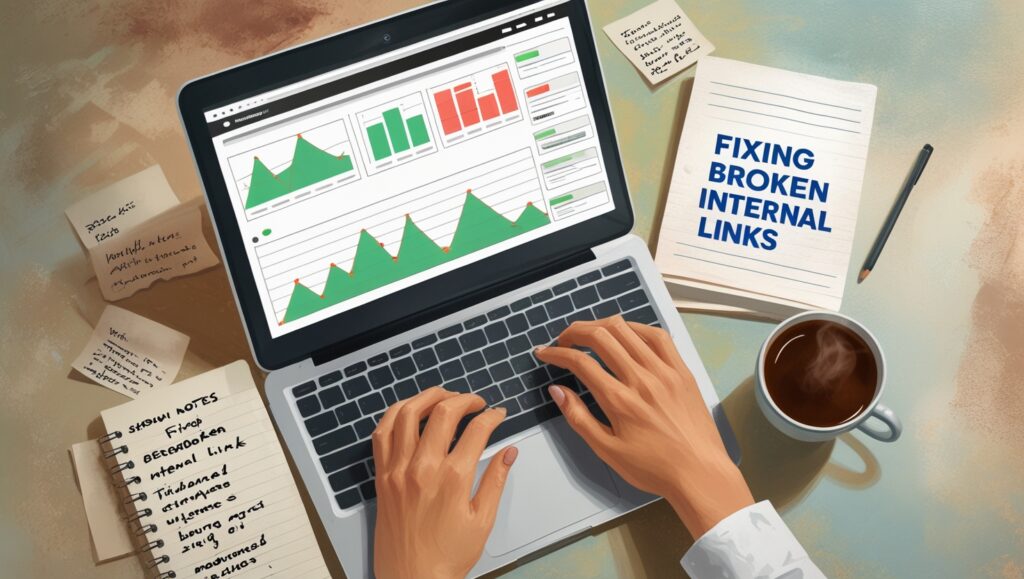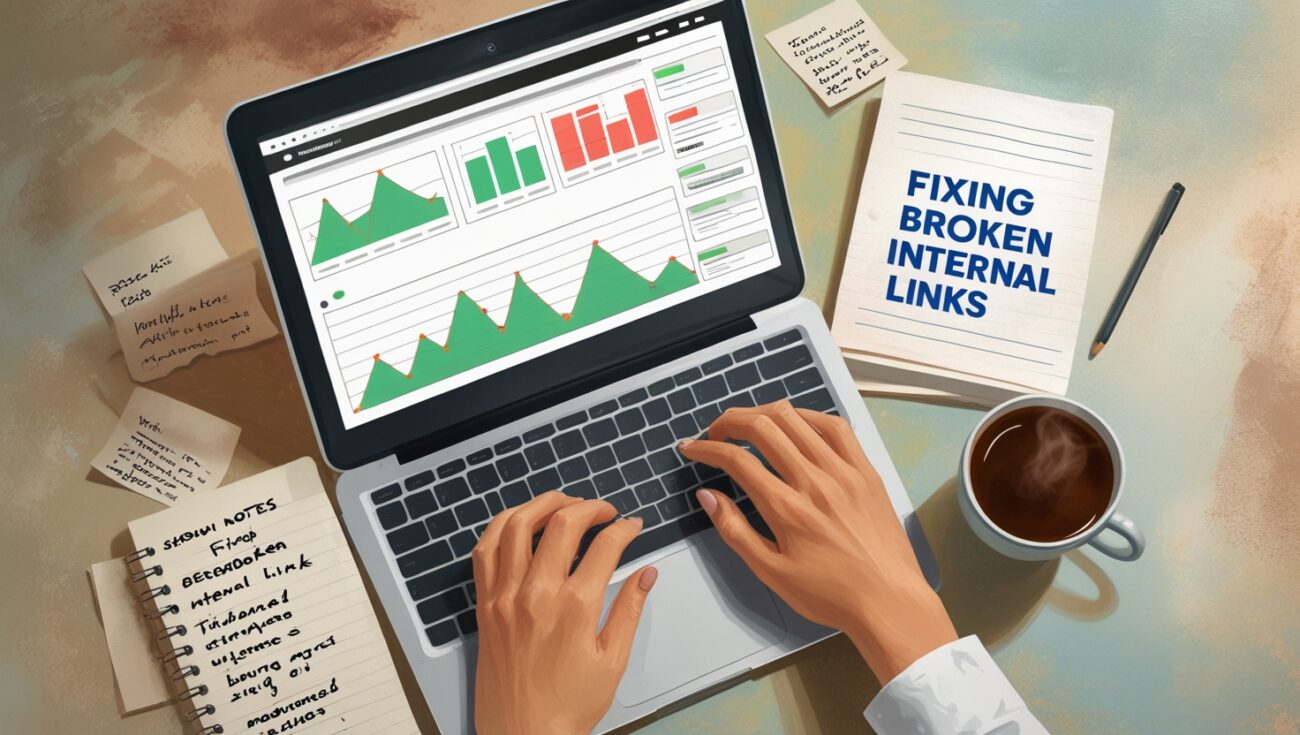How to Fix Broken Internal Links and Improve Your Site’s Health
I’ve learned that a great website isn’t just about the content you publish; it’s about the care you put into its maintenance. In my years of experience, one of the most common and damaging problems I‘ve encountered is the broken internal link. Think of it as a dead end on a roadmap. It’s frustrating for users and signals to search engines that your site is poorly maintained.

Table of Contents
While a single broken link might seem insignificant, a collection of them can severely damage your site’s SEO. They silently waste link equity and disrupt the flow of traffic. The good news is, finding and fixing them is a straightforward process, and with the right tools, it’s easier than you might think. Let me walk you through my complete guide to a healthier website.
The Hidden Dangers of Broken Internal Links
- Wasted Link Equity: Every internal link you create is a vote of confidence, passing valuable link equity from one page to another. A broken link, however, stops that flow completely. The authority you worked so hard to build is wasted, and your linked-to page gets no SEO benefit.
- Poor User Experience: When a user clicks on a link and lands on a “404 Not Found” page, it’s an immediate turn-off. This can increase your bounce rate and leave a poor impression, signaling to both users and search engines that your site is unreliable.
- Damaged Crawlability: Search engine crawlers navigate your site by following your internal links. A broken link creates a dead end, stopping the crawler’s journey and preventing it from discovering other valuable content. This can lead to unindexed pages and a less-than-optimal crawl budget.
Your Step-by-Step Guide to Finding and Fixing Broken Links
Step 1: Finding Your Broken Links
The first and most important step is to identify all of your broken internal links. While you can do this manually by clicking every link on your site (not recommended!), the most efficient way is to use a tool. Google Search Console will show you some, but for a comprehensive view, you need a dedicated tool. This is a task that automation excels at, and I’ve found it to be a massive time-saver. If you’re ready to find all of your broken links, start your Linkbot audit today.
Step 2: Understanding Your Report
Once your tool has finished its crawl, you’ll have a report. You’ll see a list of broken URLs, along with the source pages where the links are located. Prioritize fixing the broken links on your most authoritative or most-trafficked pages first, as these are the ones wasting the most link equity.
Step 3: The Fix: How to Repair Your Links
You have a few options for fixing a broken link:
- Update the Link: If the destination page has been moved or updated, simply edit the link on the source page to point to the correct, new URL. This is the best solution for retaining link equity.
- Replace the Link: If the content is no longer relevant, you can replace the broken link with a link to a new, relevant page on your site.
- Remove the Link: If there is no relevant replacement for the broken link, simply remove it.
- Implement a Redirect: If the original URL was linked to from external sites, a 301 redirect from the old, broken URL to the new, correct URL will preserve both link equity and traffic.
Beyond the Fix: Preventing Broken Links Automatically
Broken links aren’t a one-time problem. They will appear over time as you add, remove, and update content. That’s why a proactive approach is the best long-term strategy. Automated internal linking software can continuously monitor your website, alerting you to new broken links as they appear. It’s an essential piece of ongoing SEO maintenance. With Linkbot, you can automate this crucial part of your SEO and keep your site healthy.
Conclusion: Take Control of Your Site’s Health
Broken internal links are a silent killer of your site’s SEO. They waste valuable authority, harm the user experience, and disrupt search engine crawls. By taking a proactive approach to finding and fixing them, you can significantly improve your website’s health and performance.
Don’t let your valuable content sit in the shadows because of a few dead ends. Take control of your site’s SEO and ensure every article you’ve worked so hard on is contributing to your site’s overall authority. Start your journey to a healthier website with Linkbot today.
Beyond the technical side, a broken link is a clear signal of poor user experience. When a visitor hits a dead end, they are much more likely to leave your site entirely. A clean, well-maintained site that provides a smooth user journey from one page to another is crucial for building trust and contributing to the “Experience” part of your E-E-A-T score.
A consistent effort to fix broken links also builds your site’s overall trustworthiness and authority. A website riddled with errors looks unprofessional and signals to search engines that the site may not be well-maintained. A clean link profile, on the other hand, is a clear sign of quality that Google will reward with higher rankings.
By fixing broken links, you are directly helping a search engine’s ability to crawl your website. A bot follows links from page to page, and a broken link is a roadblock. When you remove that dead end, you are making it easier for the bot to discover and index more of your valuable content, ensuring your entire site is working for you.
The process of fixing broken links is a foundational part of a larger internal linking strategy. You can’t effectively pass link equity or build a strong site hierarchy if parts of your network are broken. It’s a prerequisite to any advanced SEO tactic, and it’s the first place I look when diagnosing a site’s health.
For any business owner or blogger, finding the time for a regular site audit can be a challenge. That’s why establishing a schedule is key. I personally aim for a full broken link check at least once a month, or after any major content update. This proactive approach prevents small errors from becoming major problems.
One of the greatest benefits of using an automated tool for your audit is the “to-do” list it provides. Instead of being overwhelmed by a massive report, a good tool will give you an actionable list of links to fix. It transforms a daunting task into a series of manageable steps that you can tackle in minutes.
The long-term ROI of a consistent broken link maintenance plan is undeniable. It’s a foundational SEO task that you have full control over, and the benefits—from improved rankings and traffic to a better user experience—are long-lasting and continue to grow over time. The time invested is paid back many times over.
I can say from personal experience that making this one change—from ignoring dead links to actively monitoring them—has been one of the most impactful changes I‘ve made to my website. It’s transformed my SEO efforts from a passive hope into a proactive strategy that gives me a real sense of control over my site’s destiny.
Beyond just fixing the link, a well-designed custom “404 Not Found” page can help mitigate some of the damage. By providing a friendly message and a clear path back to your most important content, you can turn a user’s frustration into a a positive experience, and guide them back to a relevant page.
A clean link profile also helps your content rank for a wider variety of keywords, especially long-tail ones. By ensuring that every internal link is passing authority to the correct destination, you’re strengthening the relevance of that page, giving it the best chance to compete for a variety of search queries.
The compounding effect of a consistent maintenance strategy is what truly makes it a hero. Each time you fix a few broken links, you’re making your entire website more authoritative and resilient. The small improvements you make on a regular basis add up to a significant SEO advantage over the long term.
Ultimately, fixing broken internal links is not just about correcting errors; it’s about building a trustworthy, high-quality website. It’s the difference between a site that works for you and one that works against you, a foundational task that every blogger and business owner should prioritize.

